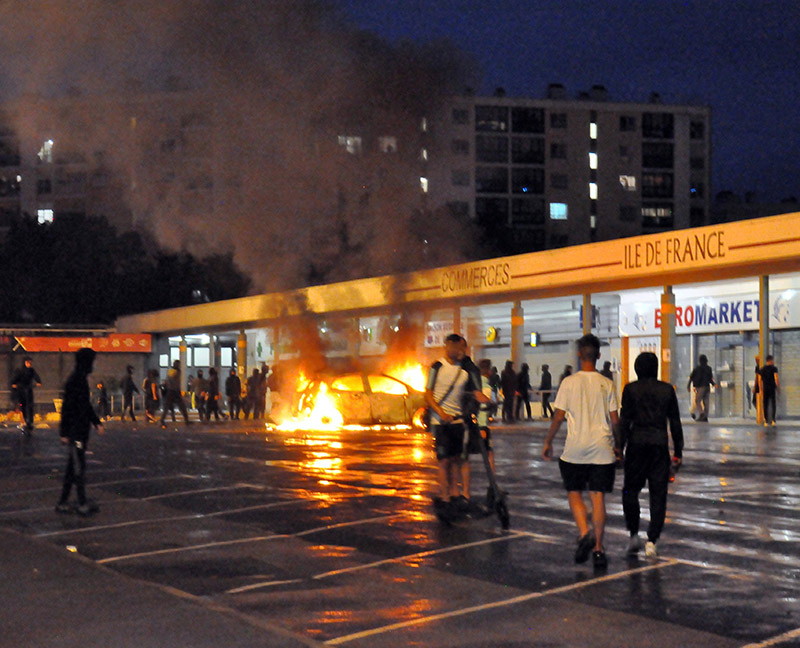Recent French riots put spotlight on migration, ghettoisation, effective criminal justice system
 Maj. Gen. Atanu Pattanaik (retd)
Maj. Gen. Atanu Pattanaik (retd)
In Fort Rucker, Alabama where I was attending the Advance Aviation Course in 1997, we would have a lunch break at 12.30 pm and reassemble at 3 pm for two more classes. One of those afternoons in July, there was an unusually heavy spell of shower. As I parked my car in the parking lot, I simply got out, slammed the door and ran for the foyer. Then I realised to my horror that not only the headlights were left on but also the car keys were left inside. The car battery would die soon and the doors were shut by the automatic locking system.
My American army aviation friends immediately understood the situation and consoled me not to worry. One said he was calling the police. “Oh my God. NO” I blurted out, saying that I didn’t do anything knowingly. It troubled me no end to imagine a police report being filed and maybe a copy endorsed to the Indian embassy in Washington DC and consequently a possible withdrawal from the course. He assured me that “they have instruments to break open car doors and retrieve the keys”. I didn’t have much choice.
A police patrol car duly pulled up. An officer in Stetson hat studied the situation, pushed the window glass down with a jack and opened the door. Handing me back my car keys after switching off the headlights, he asked me politely if anything else was needed. I just managed to mumble a thank you and walked back to the class trying to comprehend the events.
Back in India, contact with the police was to be avoided like the plague. They are known for their routine harsh treatment of ordinary citizens and it is generally a herculean task even to file a genuine complaint. The experiences of many are such that they feel as if they are criminals and not complainants. My psyche was tuned and tempered to avoid the police as far as possible and hence my reaction that day in the US, where citizens routinely seek police assistance for sundry situations.
Citizen Partnership
Depending on where they come from, and what kind of situation prevails there in terms of law and order, criminal justice system, socio-economic conditions and culture, citizens establish a particular relationship with the state and its instruments like tax collection agencies, municipal service providers and law enforcement agencies such as the police.
When immigrants settle in a foreign land, they carry with them those attitudes and prejudices. Immigrants from war-zones and from internally disturbed areas carry those worries and those memories of struggle for survival. They remember their constant efforts to somehow escape from the police that is often let loose on the masses by long serving autocrats to throttle any signs of dissent as well as from the heavily armed, rebellious and in some cases, highly radicalised militias that rampage their homelands. The peace and tranquillity, order and prosperity, the politeness and civility of the host country look surreal. And if it is their former colonial power like it is for the Algerians in France, then it looks stolen.
French Riots
Violent riots engulfed France since the unfortunate police shooting of a 17-year-old Algerian immigrant boy Nahel on 27 June 2023, at a routine traffic stop in Nanterre, just over four miles northwest of Paris. The riots spread like wildfire, engulfing the cities of Lyon and Marseilles, where the largest public library was burnt to ashes. In a way it was a replay, albeit at a much larger scale than the shocking events of 2005, when 21 days of riots shook France’s ‘banlieues’ (largely impoverished multi-racial communities) and made international headlines.
The French banlieues, or low-cost public sector housing constructed on the edge of cities and characterised by high-rise towers, were constructed between 1953and 1973 in response to a shortage of housing due to large scale destruction during the World War. Industries like Renault needed workers and the former colonies provided a good source of cheap labour. The families followed these workers as they settled into the banlieues. Following the 1973 oil crisis and subsequent industrial restructuring, many employees were made redundant, with immigrant workers often among the first to lose their jobs. They had little other skills for alternate employment and so many took to petty crime and drug peddling for survival. By the mid-1970s, these peripheral housing estates had become synonymous with marginalisation and socioeconomic exclusion.
More than five million people or roughly 10 per cent of France’s 65 million population live in some 700 banlieues. Three in five children live below the poverty line, unemployment at 22 per cent is twice the national average, rising to more than 40 per cent among young people. These youngsters are mostly second or third generation immigrants who are legitimate French citizens and do not feel the same gratitude and servile mentality of their migrant forefathers. There is a pervasive sense of humiliation and dispossession that envelopes. Within the banlieues, events called rodeos occur where the young would steal cars and perform stunts and race them. Then, before the police can catch them, they abandon the cars and set them on fire. In July and August 1981, around 250 cars were vandalised.

In 2005, riots were sparked after two young men who ran to hide in an electric transformer on seeing the police got electrocuted. France declared a state of national emergency as more than 9,000 vehicles, dozens of public buildings and businesses were set on fire. This time, the riots followed the point-blank police shooting of 17-year-old Nahel after a car chase.
After the Charlie Hebdo and kosher supermarket attacks by French gunmen from poor backgrounds, the authorities have admitted that there is a bitter social divide and there was ‘territorial, social and ethnic apartheid’ in France. The immigrants are the easy targets to be blamed, often accused of willingly or unwillingly not assimilating into the ‘mainstream’. But the moot point is that when the colonial powers entered their future colonies, they didn’t assimilate into the societies of those territories. Instead, they built their own churches, clubs, housing and schools in segregated areas and imposed their culture on the natives. Now the situation is a painful reverse, the banlieues showcasing the divide.
Europe Engulfed
The riots have spread to Switzerland and Belgium. Sweden is on the edge. German has large swathes of crime-prone and ‘autonomous’ ghettos of immigrants from Turkey in the initial years and since 2015, from Syria, Iraq and Afghanistan. The debate on immigrants is back on the table. The Italian far-right government of Prime Minister Giorgia Meloni is tightening the noose on immigration. The Dutch government of Prime Minister Mark Rutte has just fallen over disagreements on immigration policies between coalition partners. Poland stubbornly refuses to allow non-Christian immigrants defying the European Union diktat and now proudly proclaims it is still very peaceful.
The migration from the erstwhile colonies to the coloniser countries after World War II was one pattern. These people were familiar with the customs and cultures of their former masters and looked up to the ‘mother country’ for education and opportunities. The relocations were mostly migration of choice and they made efforts to assimilate into their host societies. This changed after the Global War on Terrorism in 2001, when relentless conflict in home countries forced an influx of refugees seeking security and migrants seeking a better life.
The European population has been on the decline. ‘Replacement level fertility,’ which is the total fertility rate at which a population exactly replaces itself from one generation to the next without migration is 2.1 per the average number of children born per woman. The current fertility rates in the EU are 1.53, much below the replenishment rates. To sustain its economy including industry, agriculture and services, it needs migrants. Millions of migrants were welcomed by various European countries such as Germany, Italy and Sweden for these very reasons. In fact, Germany is one of the most popular destinations for immigrants in the world, with well over 1 million people moving there each year since 2013. It is the same as that moving into the US each year but qualitatively very different.
Across Atlantic
In the US, the fate of millions of undocumented immigrants is hot recipe for electoral battles. Among Democrats and Democratic-leaning independents, 88 per cent think immigrants strengthen the country with their hard work and talent and just 8 per cent say they are a burden. Among Republicans and Republican-leaning independents, 41 per cent say immigrants strengthen the country, while 44 per cent say they burden it. Paradoxically, the US itself was created out of migrants’ settlements from Europe in the eighteenth century and often describes itself as a nation of immigrants.
Post World War II, attracted by its economy, entrepreneurial and innovation ecosystem and its universities, the trend continued. The US has more immigrants than any other country in the world. Today, more than 40 million people living in the US were born in another country, accounting for about one-fifth of the world’s migrants. The population of immigrants is also very diverse, with just about every country in the world represented among US immigrants.
The income levels, education and assimilation into the mainstream society, which appear to be at the forefront of the discourse in the ongoing riots in France and other European countries, are also factors in the US. Some sections of immigrants such as those from India, which constitute about 3 million, education and income levels are higher than the national average. They have assimilated very well with some occupying high positions in federal and state governments, including Governors, Congressmen, Ambassadors and most visibly in the tech sector where some 25 ‘Fortune 500’ companies are headed by persons of Indian origin. But the picture is different for those from Mexico and the rest of Latin America. As the central and South American countries witness internal turmoil due to drug wars, adverse climate events, sheer poor governance and blatant American interference for a regime change, the US has been finding it increasingly challenging to check the floodgates.
Racial discrimination and sectarian divide appear to be the hot mix that has fuelled the French riots and that has gone beyond the control of the state apparatus. But this is not a French problem alone. Even after centuries of their forefathers having been shipped as slaves to the US to work on their agricultural estates, the African-Americans continue to face racial discrimination. Mass and sometimes violent uprisings like the ‘Black Lives Matter’ movements remind the world that apartheid is alive and kicking in these so-called liberal and progressive societies.
Implications for India
India has a big stake in how the French riots and those spreading it to other parts of Europe play out. India continues to be the main origin of international migrants with over 17.5 million Indian-born people living abroad. At the same time India houses perhaps the most mixed conglomeration of races and faiths. What is the take-away for India from these riots?
One, that citizens must trust the governments for their well-being and the latter should create and run an effective criminal justice system. Two, the state must endeavour to establish a harmonious environment that promotes merit and scholarship without prejudice and there should be fair access to jobs, education and healthcare without overt and covert state as well as societal discrimination. Three, ghettoisation must be actively discouraged while being alert for communal strife. The French riots have put the spotlight on the immigrants as never before.

